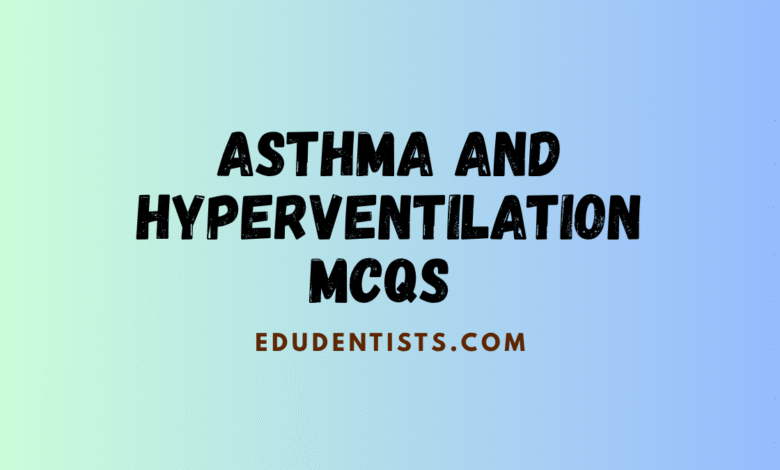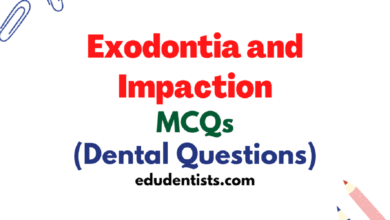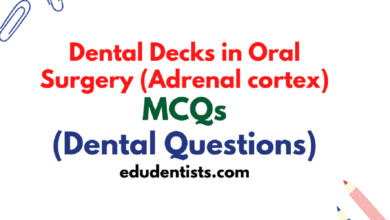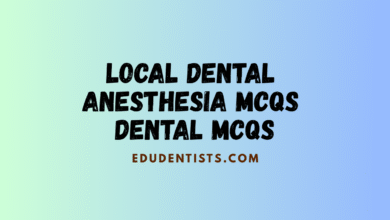Oral and Maxillofacial Surgery MCQs
MCQs on Medical Emergencies in Dentistry: Asthma and Hyperventilation
MCQs on Medical Emergencies in Dentistry: Asthma and Hyperventilation

MCQs on Medical Emergencies in Dentistry: Asthma and Hyperventilation
🧠 MCQs on Medical Emergencies in Dentistry: Asthma and Hyperventilation
General Medical Emergencies
- Which of the following is one of the most common medical emergencies in dental offices?
A. Seizures
B. Stroke
C. Asthma attack
D. Myocardial infarction - What is the first step when a medical emergency occurs in the dental chair?
A. Administer medication
B. Stop all dental treatment
C. Start CPR
D. Ask the patient to breathe faster - What percentage of dental clinics report at least one medical emergency annually?
A. 10%
B. 25%
C. 44%
D. 60% - Which vital emergency equipment should be present in every dental clinic?
A. ECG machine
B. Oxygen tank and epinephrine
C. Dental scaler
D. Suction tip only - Which of the following is not a common trigger of dental emergencies?
A. Pain
B. Anxiety
C. Infection
D. Fluoride treatment
Asthma
- Asthma is primarily a:
A. Cardiac condition
B. Respiratory condition
C. Digestive condition
D. Neurological condition - What causes airway obstruction in asthma?
A. Foreign body
B. Bronchial inflammation and mucus
C. Blood clots
D. Dental instruments - The most common form of asthma is:
A. Intrinsic
B. Extrinsic
C. Infectious
D. Chronic obstructive - Intrinsic asthma usually begins:
A. At birth
B. In early childhood
C. After age 35
D. During puberty - A patient with intrinsic asthma may have:
A. No symptoms between attacks
B. Chronic cough with sputum
C. Fainting spells
D. Seizures
Asthma Management
- What should be done first during an asthma attack in the dental chair?
A. Administer epinephrine
B. Stop treatment and remove materials
C. Call EMS
D. Perform CPR - The correct patient position during an asthma attack is:
A. Supine
B. Upright
C. Prone
D. Trendelenburg - The primary medication used by patients during an asthma attack is:
A. Epinephrine
B. Oxygen
C. Salbutamol inhaler (bronchodilator)
D. Diazepam - If the inhaler is ineffective, the next drug administered is:
A. Epinephrine
B. Nitroglycerin
C. Atropine
D. Antibiotic - What dose of epinephrine is typically given to adults during an asthma emergency?
A. 0.1 mL
B. 0.3–0.5 mL of 1:1000 IM
C. 1.5 mL
D. 10 mL
Asthma and Oral Health
- Which oral complication is linked to asthma inhaler use?
A. Oral candidiasis
B. Halitosis
C. Gingival recession
D. Aphthous ulcers - What advice should be given after using an inhaler?
A. Drink soda
B. Swallow water
C. Rinse mouth with water
D. Avoid brushing teeth - Asthma medications can increase the risk of:
A. Periodontitis
B. Dental caries
C. Tooth erosion
D. TMJ pain Dry mouth from medication leads to more caries.
Hyperventilation
- Hyperventilation is most often caused by:
A. Allergic reaction
B. Anxiety or stress
C. Diabetes
D. Infection - Hyperventilation leads to:
A. Increase in CO₂
B. Decrease in CO₂
C. Hypoglycemia
D. Bradycardia - What acid-base imbalance occurs during hyperventilation?
A. Metabolic acidosis
B. Respiratory alkalosis due to excess CO₂ loss
C. Metabolic alkalosis
D. Respiratory acidosis - Which of the following is NOT a symptom of hyperventilation?
A. Tingling in hands
B. Chest tightness
C. Dizziness
D. Cyanosis - What is the first management step in a hyperventilation episode?
A. Administer oxygen
B. Stop treatment and calm patient
C. Inject epinephrine
D. Lay the patient flat - The patient should be instructed to:
A. Breathe faster
B. Breathe slowly and hold breath briefly
C. Drink cold water
D. Use inhaler - Oxygen should be given to a hyperventilating patient:
A. Immediately
B. Never
C. Only with epinephrine
D. After 10 minutes
Hyperventilation—Advanced Management
- In severe cases, which drug may be used to calm a hyperventilating patient?
A. Epinephrine
B. Diazepam
C. Salbutamol
D. Nitroglycerin - What breathing technique is best for hyperventilation?
A. Mouth-only breathing
B. Slow, controlled breathing
C. Shallow gasps
D. Holding breath indefinitely - Which age group is least likely to hyperventilate?
A. Children
B. Teenagers
C. Adults
D. Elderly
Emergency Readiness
- How often should emergency kits in dental clinics be checked?
A. Monthly
B. Annually
C. Regularly, per office policy
D. Never - What essential drug is used in both asthma and anaphylaxis?
A. Epinephrine
B. Diazepam
C. Nitroglycerin
D. Atropine
True/False
- Hyperventilation leads to respiratory acidosis.
A. True
B. False It leads to respiratory alkalosis. - Asthma is usually triggered by lack of oxygen.
A. True
B. False It’s caused by airway inflammation and constriction, not oxygen lack alone. - Bronchodilators help open the airways in asthma.
A. True
B. False They relax the bronchial muscles. - It is safe to give oxygen to all patients during an emergency.
A. True
B. False Hyperventilating patients should not receive oxygen. - Hyperventilation is common in nervous dental patients.
A. True
B. False Anxiety is the main trigger.





